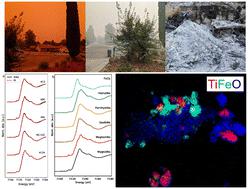当前位置:
X-MOL 学术
›
Environ. Sci.: Nano
›
论文详情
Our official English website, www.x-mol.net, welcomes your
feedback! (Note: you will need to create a separate account there.)
Discovery and potential ramifications of reduced iron-bearing nanoparticles—magnetite, wüstite, and zero-valent iron—in wildland–urban interface fire ashes
Environmental Science: Nano ( IF 5.8 ) Pub Date : 2022-08-09 , DOI: 10.1039/d2en00439a Mohammed Baalousha 1 , Morgane Desmau 2 , Sheryl A. Singerling 3 , Jackson P. Webster 4 , Sandrine J. Matiasek 5 , Michelle A. Stern 6 , Charles N. Alpers 6
Environmental Science: Nano ( IF 5.8 ) Pub Date : 2022-08-09 , DOI: 10.1039/d2en00439a Mohammed Baalousha 1 , Morgane Desmau 2 , Sheryl A. Singerling 3 , Jackson P. Webster 4 , Sandrine J. Matiasek 5 , Michelle A. Stern 6 , Charles N. Alpers 6
Affiliation

|
The increase in fires at the wildland–urban interface has raised concerns about the potential environmental impact of ash remaining after burning. Here, we examined the concentrations and speciation of iron-bearing nanoparticles in wildland–urban interface ash. Total iron concentrations in ash varied between 4 and 66 mg g−1. Synchrotron X-ray absorption near-edge structure (XANES) spectroscopy of bulk ash samples was used to quantify the relative abundance of major Fe phases, which were corroborated by transmission electron microscopy measurements. Maghemite (γ-(Fe3+)2O3) and magnetite (γ-Fe2+(Fe3+)2O4) were detected in most ashes and accounted for 0–90 and 0–81% of the spectral weight, respectively. Ferrihydrite (amorphous Fe(III)–hydroxide, (Fe3+)5HO8·4H2O), goethite (α-Fe3+OOH), and hematite (α-Fe3+2O3) were identified less frequently in ashes than maghemite and magnetite and accounted for 0–65, 0–54, and 0–50% of spectral weight, respectively. Other iron phases identified in ashes include wüstite (Fe2+O), zerovalent iron, FeS, FeCl2, FeCl3, FeSO4, Fe2(SO4)3, and Fe(NO3)3. Our findings demonstrate the impact of fires at the wildland–urban interface on iron speciation; that is, fires can convert iron oxides (e.g., maghemite, hematite, and goethite) to reduced iron phases such as magnetite, wüstite, and zerovalent iron. Magnetite concentrations (e.g., up to 25 mg g−1) decreased from black to gray to white ashes. Based on transmission electron microscopy (TEM) analyses, most of the magnetite nanoparticles were less than 500 nm in size, although larger particles were identified. Magnetite nanoparticles have been linked to neurodegenerative diseases as well as climate change. This study provides important information for understanding the potential environmental impacts of fires at the wildland–urban interface, which are currently poorly understood.
中文翻译:

在荒地-城市界面火灰中发现还原的含铁纳米颗粒(磁铁矿、方镁石和零价铁)及其潜在影响
荒地-城市交界处火灾的增加引起了人们对燃烧后残留的灰烬对环境的潜在影响的担忧。在这里,我们检查了荒地 - 城市界面灰烬中含铁纳米颗粒的浓度和形态。灰分中的总铁浓度在 4 到 66 mg g -1之间变化。使用大块灰样品的同步加速器 X 射线吸收近边结构 (XANES) 光谱来量化主要 Fe 相的相对丰度,这通过透射电子显微镜测量得到了证实。磁赤铁矿(γ-(Fe 3+ ) 2 O 3 )和磁铁矿(γ-Fe 2+ (Fe 3+ ) 2 O 4)在大多数灰烬中检测到,分别占光谱权重的 0-90% 和 0-81%。水铁矿(无定形 Fe( III )-氢氧化物、(Fe 3+ ) 5 HO 8 ·4H 2 O)、针铁矿(α-Fe 3+ OOH)和赤铁矿(α-Fe 3+ 2 O 3)的鉴定频率较低在灰烬中的含量高于磁赤铁矿和磁铁矿,分别占光谱重量的 0-65%、0-54% 和 0-50%。灰烬中鉴定的其他铁相包括方镁石 (Fe 2+ O)、零价铁、FeS、FeCl 2、FeCl 3、FeSO 4、Fe 2 (SO 4 )3和Fe(NO 3 ) 3。我们的研究结果证明了荒地-城市界面的火灾对铁物种形成的影响;也就是说,火可以将氧化铁(例如磁赤铁矿、赤铁矿和针铁矿)转化为还原铁相,例如磁铁矿、方铁矿和零价铁。磁铁矿浓度(例如,高达 25 mg g -1) 从黑色到灰色再到白色灰烬。根据透射电子显微镜 (TEM) 分析,大多数磁铁矿纳米颗粒的尺寸小于 500 nm,尽管发现了较大的颗粒。磁铁矿纳米颗粒与神经退行性疾病以及气候变化有关。这项研究为了解野地-城市界面火灾的潜在环境影响提供了重要信息,目前人们对此知之甚少。
更新日期:2022-08-09
中文翻译:

在荒地-城市界面火灰中发现还原的含铁纳米颗粒(磁铁矿、方镁石和零价铁)及其潜在影响
荒地-城市交界处火灾的增加引起了人们对燃烧后残留的灰烬对环境的潜在影响的担忧。在这里,我们检查了荒地 - 城市界面灰烬中含铁纳米颗粒的浓度和形态。灰分中的总铁浓度在 4 到 66 mg g -1之间变化。使用大块灰样品的同步加速器 X 射线吸收近边结构 (XANES) 光谱来量化主要 Fe 相的相对丰度,这通过透射电子显微镜测量得到了证实。磁赤铁矿(γ-(Fe 3+ ) 2 O 3 )和磁铁矿(γ-Fe 2+ (Fe 3+ ) 2 O 4)在大多数灰烬中检测到,分别占光谱权重的 0-90% 和 0-81%。水铁矿(无定形 Fe( III )-氢氧化物、(Fe 3+ ) 5 HO 8 ·4H 2 O)、针铁矿(α-Fe 3+ OOH)和赤铁矿(α-Fe 3+ 2 O 3)的鉴定频率较低在灰烬中的含量高于磁赤铁矿和磁铁矿,分别占光谱重量的 0-65%、0-54% 和 0-50%。灰烬中鉴定的其他铁相包括方镁石 (Fe 2+ O)、零价铁、FeS、FeCl 2、FeCl 3、FeSO 4、Fe 2 (SO 4 )3和Fe(NO 3 ) 3。我们的研究结果证明了荒地-城市界面的火灾对铁物种形成的影响;也就是说,火可以将氧化铁(例如磁赤铁矿、赤铁矿和针铁矿)转化为还原铁相,例如磁铁矿、方铁矿和零价铁。磁铁矿浓度(例如,高达 25 mg g -1) 从黑色到灰色再到白色灰烬。根据透射电子显微镜 (TEM) 分析,大多数磁铁矿纳米颗粒的尺寸小于 500 nm,尽管发现了较大的颗粒。磁铁矿纳米颗粒与神经退行性疾病以及气候变化有关。这项研究为了解野地-城市界面火灾的潜在环境影响提供了重要信息,目前人们对此知之甚少。











































 京公网安备 11010802027423号
京公网安备 11010802027423号